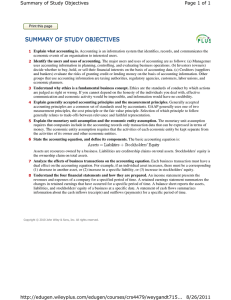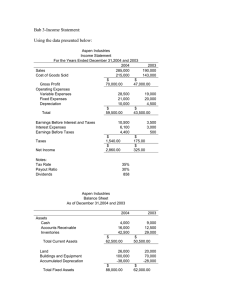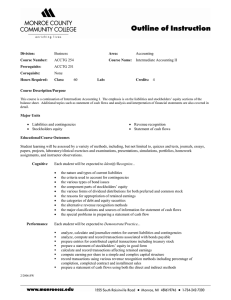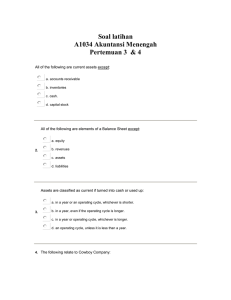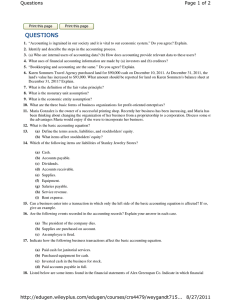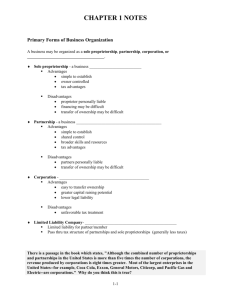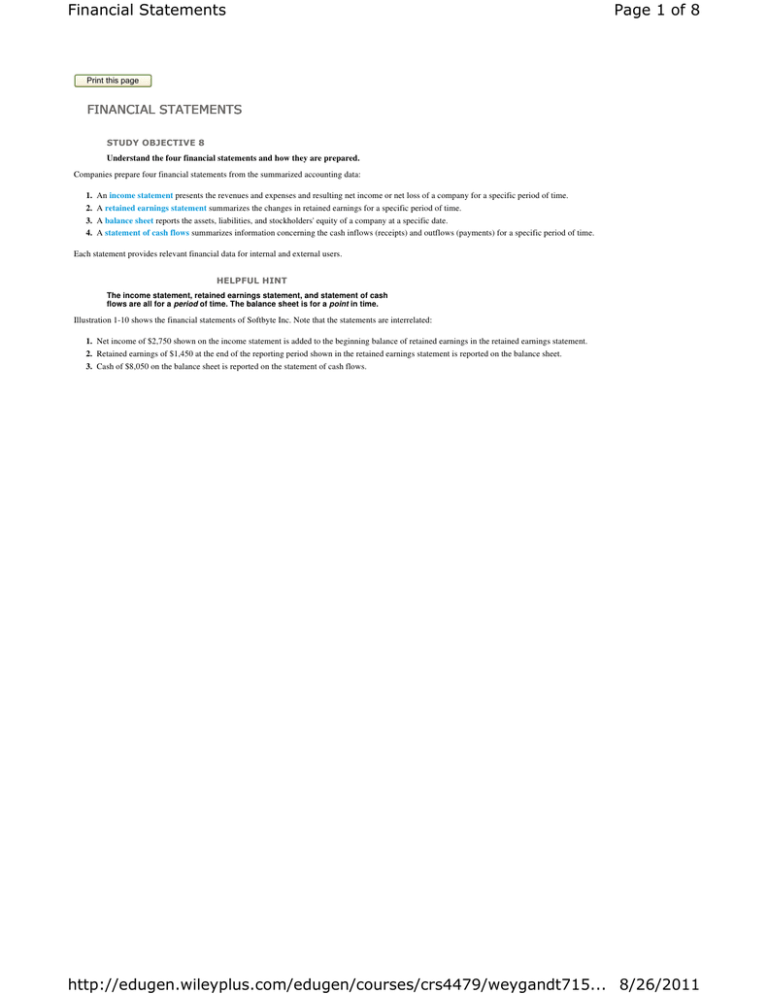
Financial Statements
Page 1 of 8
Print this page
FINANCIAL STATEMENTS
STUDY OBJECTIVE 8
Understand the four financial statements and how they are prepared.
Companies prepare four financial statements from the summarized accounting data:
1.
2.
3.
4.
An income statement presents the revenues and expenses and resulting net income or net loss of a company for a specific period of time.
A retained earnings statement summarizes the changes in retained earnings for a specific period of time.
A balance sheet reports the assets, liabilities, and stockholders' equity of a company at a specific date.
A statement of cash flows summarizes information concerning the cash inflows (receipts) and outflows (payments) for a specific period of time.
Each statement provides relevant financial data for internal and external users.
HELPFUL HINT
The income statement, retained earnings statement, and statement of cash
flows are all for a period of time. The balance sheet is for a point in time.
Illustration 1-10 shows the financial statements of Softbyte Inc. Note that the statements are interrelated:
1. Net income of $2,750 shown on the income statement is added to the beginning balance of retained earnings in the retained earnings statement.
2. Retained earnings of $1,450 at the end of the reporting period shown in the retained earnings statement is reported on the balance sheet.
3. Cash of $8,050 on the balance sheet is reported on the statement of cash flows.
http://edugen.wileyplus.com/edugen/courses/crs4479/weygandt715... 8/26/2011
Financial Statements
Page 2 of 8
Illustration 1-10 Financial statements and their interrelationships
HELPFUL HINT
The heading of each statement identifies the company, the type of statement,
and the specific date or time period covered by the statement.
HELPFUL HINT
The four financial state-ments are prepared in the sequence shown, for the
following reasons:
· Net income is computed first and is needed to determine the ending
balance in retained earnings.
· The ending balance in retained earnings is needed in preparing the
balance sheet.
· The cash shown on the balance sheet is needed in preparing the
statement of cash flows.
HELPFUL HINT
http://edugen.wileyplus.com/edugen/courses/crs4479/weygandt715... 8/26/2011
Financial Statements
Page 3 of 8
Note that final sums are double-underlined, and negative amounts are
presented in parentheses.
Also, explanatory notes and supporting schedules are an integral part of every set of financial statements. We illustrate examples of these notes and schedules in later chapters of
this textbook.
HELPFUL HINT
There is only one group of notes for the whole set of financial statements,
rather than separate sets of notes for each financial statement.
Be sure to carefully examine the format and content of each statement in Illustration 1-10. We describe the essential features of each in the following sections.
Income Statement
ALTERNATIVE TERMINOLOGY
The income statement is sometimes referred to as the statement of
operations, earnings statement, or profit and loss statement.
Alternative Terminology notes present synonymous terms that you may come
across in practice.
The income statement reports the success or profitability of the company's operations over a specific period of time. For example, Softbyte Inc.'s income statement is dated “For the
Month Ended September 30, 2011.” It is prepared from the data appearing in the revenue and expense columns of Illustration 1-9. The heading of the statement identifies the
company, the type of statement, and the time period covered by the statement.
The income statement lists revenues first, followed by expenses. Finally, the statement shows net income (or net loss). When revenues exceed expenses, net income results. When
expenses exceed revenues, a net loss results.
Although practice varies, we have chosen in our illustrations and homework solutions to list expenses in order of magnitude. (We will consider alternative formats for the income
statement in later chapters.)
Note that the income statement does not include investment and dividend transactions between the stockholders and the business in measuring net income. For example, as
explained earlier, the cash dividend from Softbyte Inc. was not regarded as a business expense. This type of transaction is considered a reduction of retained earnings, which causes
a decrease in stockholders' equity.
Retained Earnings Statement
Softbyte Inc.'s retained earnings statement reports the changes in retained earnings for a specific period of time. The time period is the same as that covered by the income statement
(“For the Month Ended September 30, 2011”). Data for the preparation of the retained earnings statement come from the retained earnings columns of the tabular summary
(Illustration 1-9) and from the income statement (Illustration 1-10).
The first line of the statement shows the beginning retained earnings amount. Then come net income and dividends. The retained earnings ending balance is the final amount on the
statement. The information provided by this statement indicates the reasons why retained earnings increased or decreased during the period. If there is a net loss, it is deducted with
dividends in the retained earnings statement.
Balance Sheet
Softbyte Inc.'s balance sheet reports the assets, liabilities, and stockholders' equity at a specific date (September 30, 2011). The company prepares the balance sheet from the column
headings and the month-end data shown in the last line of the tabular summary (Illustration 1-9).
Observe that the balance sheet lists assets at the top, followed by liabilities and stockholders' equity. Total assets must equal total liabilities and stockholders' equity. Softbyte Inc.
reports only one liability, accounts payable, on its balance sheet. In most cases, there will be more than one liability. When two or more liabilities are involved, a customary way of
listing is as shown in Illustration 1-11.
Illustration 1-11 Presentation of liabilities
The balance sheet is like a snapshot of the company's financial condition at a specific moment in time (usually the month-end or year-end).
ACCOUNTING ACROSS THE ORGANIZATION
What Do General Mills, Walt Disney, and Dunkin' Donuts Have in Common?
http://edugen.wileyplus.com/edugen/courses/crs4479/weygandt715... 8/26/2011
Financial Statements
Page 4 of 8
Not every company uses December 31 as the accounting year-end. Some companies whose year-ends differ from December 31 are General Mills, May 27; Walt Disney
Productions, September 30; and Dunkin' Donuts Inc., October 31. Why do companies choose the particular year-ends that they do? Many choose to end the accounting
year when inventory or operations are at a low. Compiling accounting information requires much time and effort by managers, so companies would rather do it when they
aren't as busy operating the business. Also, inventory is easier and less costly to count when it is low.
? What year-end would you likely use if you owned a ski resort and ski rental business?
Answer:
Probable choices for a ski resort would be between May 31 and August 31.
? What if you owned a college bookstore?
Answer:
For a college bookstore, a likely year-end would be June 30.
? Why choose those year-ends?
Answer:
The optimum accounting year-end, especially for seasonal businesses, is a point when inventory and activities are lowest.
Statement of Cash Flows
HELPFUL HINT
Investing activities pertain to investments made by the company, not
investments made by the owner.
The statement of cash flows provides information on the cash receipts and payments for a specific period of time. The statement of cash flows reports (1) the cash effects of a
company's operations during a period, (2) its investing transactions, (3) its financing transactions, (4) the net increase or decrease in cash during the period, and (5) the cash amount
at the end of the period.
Reporting the sources, uses, and change in cash is useful because investors, creditors, and others want to know what is happening to a company's most liquid resource. The
statement of cash flows provides answers to the following simple but important questions.
1. Where did cash come from during the period?
2. What was cash used for during the period?
3. What was the change in the cash balance during the period?
As shown in Softbyte Inc.'s statement of cash flows in Illustration 1-10, cash increased $8,050 during the period. Net cash flow provided from operating activities increased cash
$1,350. Cash flow from investing transactions decreased cash $7,000. And cash flow from financing transactions increased cash $13,700. At this time, you need not be concerned
with how these amounts are determined. Chapter 14 will examine in detail how the statement is prepared.
before you go on...
Financial Statement Items
Presented below is selected information related to Flanagan Corporation at December 31, 2011. Flanagan reports financial information monthly.
Office Equipment
Cash
$10,000
8,000
Utilities Expense
9,000
7,000
Service Revenue
36,000
Wages Expense
Rent Expense
11,000
Notes Payable
Accounts Payable
2,000
$ 4,000
Accounts Receivable
Drawings
16,500
5,000
(a) Determine the total assets of Flanagan Corporation at December 31, 2011.
(b) Determine the net income that Flanagan Corporation reported for December 2011.
(c) Determine the stockholders' equity of Flanagan Corporation at December 31, 2011.
http://edugen.wileyplus.com/edugen/courses/crs4479/weygandt715... 8/26/2011
Financial Statements
Page 5 of 8
Solution
Action Plan
Remember the basic accounting equation: assets must equal liabilities plus stockholders' equity.
Review previous financial statements to determine how total assets, net income, and stockholders' equity are computed.
(a) The total assets are $27,000, comprised of Cash $8,000, Accounts Receivable $9,000, and Office Equipment $10,000.
(b) Net income is $14,000, computed as follows:
Revenues
Service revenue
$36,000
Expenses
Rent expense
$11,000
Wages expense
7,000
Utilities expense
4,000
Total expenses
22,000
Net income
$14,000
(c) The ending stockholders' equity of Flanagan Corporation is $8,500. By rewriting the accounting equation, we can compute stockholders' equity as assets minus
liabilities, as follows:
Total assets [as computed in (a)]
$27,000
Less: Liabilities
Notes payable
Accounts payable
Stockholders' equity
$16,500
2,000
18,500
$ 8,500
Note that it is not possible to determine the corporation's stockholders' equity in any other way because the beginning total for stockholders' equity is not
provided.
Related exercise material: BE1-10, BE1-11, E1-8, E1-10, E1-11, and
1-4.
Be sure to read ALL ABOUT YOU Ethics: Managing Personal Financial
Reporting on page 26 for information on how topics in this chapter apply to
your personal life.
all about YOU
Ethics: Managing Personal Financial Reporting
When companies need money, they go to investors or creditors. Before investors or creditors will give a company cash, they want to know the company's financial position
and performance. They want to see the company's financial statements—the balance sheet and the income statement. When students need money for school, they often
apply for financial aid. When you apply for financial aid, you must submit your own version of a financial statement—the Free Application for Federal Student Aid
(FAFSA) form.
The FAFSA form asks how much you make (based on your federal income tax return) and how much your parents make. The purpose is to find out how much you own and
how much you owe. Why do the Department of Education and your school want this information? Simple: They want to know whether you really need the money. Schools
and government-loan funds have limited resources, and they want to make sure that the money goes to those who need it the most. The bottom line is: The worse off you
look financially, the more likely you are to get money.
The question is: Should you intentionally make yourself look worse off than you are?
Some Facts
· After adjusting for inflation, private-college tuition and fees have increased 37% over the past decade; public-college tuition has risen 54%.
· Two-thirds (65.6%) of undergraduate students graduate with some debt.
· Among graduating seniors, the average debt load is $19,202, according to an analysis of data from the Department of Education's National Postsecondary Student Aid
Study. That does not include any debt that their parents might incur.
· Colleges are required to audit the FAFSA forms of at least one-third of their students; some audit 100%. (Compare that to the IRS, which audits a very small
percentage of tax returns.) Thus, if you lie on your financial aid forms, there's a very good chance you'll get caught.
Additional information regarding scholarships and loans is available at
www.finaid.org/. You might find especially interesting the section that
discusses how to maximize your chances of obtaining financial aid at
www.finaid.org/fafsa/maximize.phtml.
http://edugen.wileyplus.com/edugen/courses/crs4479/weygandt715... 8/26/2011
Financial Statements
Page 6 of 8
Source for graph: College Board, Princeton Review, as reported in “College Admissions: Is Gate Open or Closed?,” Wall Street Journal, March 25, 2006, p. A7.
What Do You Think?
Consider the following and decide what action you would take:
Suppose you have $4,000 in cash and $4,000 in credit card bills. The more cash and other assets that you have, the less likely you are to get financial aid. Also, if you have a
lot of consumer debt (credit card bills), schools are not more likely to loan you money. To increase your chances of receiving aid, should you use the cash to pay off your
credit card bills, and therefore make yourself look “worse off” to the financial aid decision makers?
Yes: You are playing within the rules. You are not hiding assets. You are simply restructuring your assets and liabilities to best conform with the preferences that are built
into the federal aid formulas.
No: You are engaging in a transaction solely to take advantage of a loophole in the federal aid rules. In doing so, you are potentially depriving someone who is actually
worse off than you from receiving aid.
The authors' comments on this situation.
In this chapter you saw that there are very specific rules governing the recording of assets, liabilities, revenues, and expenses. However, within these rules there is a lot of
room for judgment. It would not be at all unusual for two experienced accountants, when faced with identical situations, to arrive at different results.
Similarly, in reporting your financial situation for financial aid there is a lot of room for judgment. The question is, what kinds of actions are both permissible and ethical,
and what kinds of actions are illegal and unethical? It might be argued that paying off your credit card debt to reduce your assets is legal and ethical. It is true that you have
intentionally changed the nature of your assets in order to improve your chances of getting aid. You did so, however, through a legitimate transaction. In fact, given the high
interest rates charged on credit card bills, it would probably be a good idea to use the cash to pay off your bills even if you aren't applying for aid.
Now, consider an alternative situation. Suppose that you have $10,000 in cash, and you have a sibling who is five years younger than you. Should you “give” the cash to
your sibling while you are being considered for financial aid? This would give the appearance of substantially reducing your assets, and thus increase the likelihood that you
will receive aid. Most people would argue that this is unethical, and it is probably illegal.
When completing your FAFSA form, don't ignore the following warning on the front of the form: “If you get Federal student aid based on incorrect information, you will
have to pay it back; you may also have to pay fines and fees. If you purposely give false or misleading information on your application, you may be fined $20,000, sent to
prison, or both.”
Sources: “College Admissions: Is Gate Open or Closed?,” Wall Street Journal, March 25, 2006, P. A7; www.finaid.org.
Comprehensive
DO IT!
The Comprehensive Do it! is a final review of the chapter. The Action Plan
gives tips about how to approach the problem, and the Solution demonstrates
both the form and content of complete answers.
Legal Services Inc. was incorporated on July 1, 2011. During the first month of operations, the following transactions occurred.
1.
2.
3.
4.
5.
6.
7.
Stockholders invested $10,000 in cash in exchange for common stock of Legal Services Inc.
Paid $800 for July rent on office space.
Purchased office equipment on account $3,000.
Provided legal services to clients for cash $1,500.
Borrowed $700 cash from a bank on a note payable.
Performed legal services for client on account $2,000.
Paid monthly expenses: salaries $500, utilities $300, and telephone $100.
Instructions
(a) Prepare a tabular summary of the transactions.
(b) Prepare the income statement, retained earnings statement, and balance sheet at July 31 for Legal Services Inc.
Solution to Comprehensive
Action Plan
http://edugen.wileyplus.com/edugen/courses/crs4479/weygandt715... 8/26/2011
Financial Statements
Page 7 of 8
Make sure that assets equal liabilities plus stockholders' equity after each transaction.
Investments and revenues increase stockholders' equity. Dividends and expenses decrease stockholders' equity.
Prepare the financial statements in the order listed.
The income statement shows revenues and expenses for a period of time.
The retained earnings statement shows the changes in retained earnings for the same period of time as the income statement.
The balance sheet reports assets, liabilities, and stockholders' equity at a specific date.
(a)
(b)
LEGAL SERVICES INC.
INCOME STATEMENT
For the Month Ended July 31, 2011
Revenues
Service revenue
$3,500
Expenses
Rent expense
$800
Salaries expense
500
Utilities expense
300
Telephone expense
100
Total expenses
Net income
1,700
$1,800
LEGAL SERVICES INC.
RETAINED EARNINGS STATEMENT
For the Month Ended July 31, 2011
Retained earnings, July 1
Add: Net income
$ ;–0–
1,800
Retained earnings, July 31
$1,800
LEGAL SERVICES INC.
BALANCE SHEET
July 31, 2011
Assets
Cash
$10,500
Accounts receivable
2,000
Equipment
3,000
Total assets
$15,500
Liabilities and Stockholders' Equity
Liabilities
Notes payable
$ 700
Accounts payable
3,000
Total liabilities
3,700
Stockholders' equity
Common stock
Retained earnings
Total liabilities and stockholders' equity
$10,000
1,800
11,800
$15,500
http://edugen.wileyplus.com/edugen/courses/crs4479/weygandt715... 8/26/2011
Financial Statements
Page 8 of 8
Copyright © 2010 John Wiley & Sons, Inc. All rights reserved.
http://edugen.wileyplus.com/edugen/courses/crs4479/weygandt715... 8/26/2011

